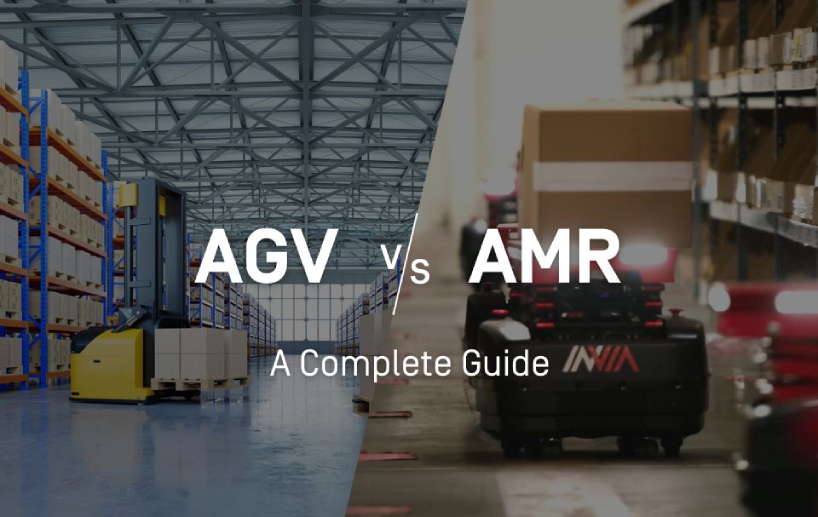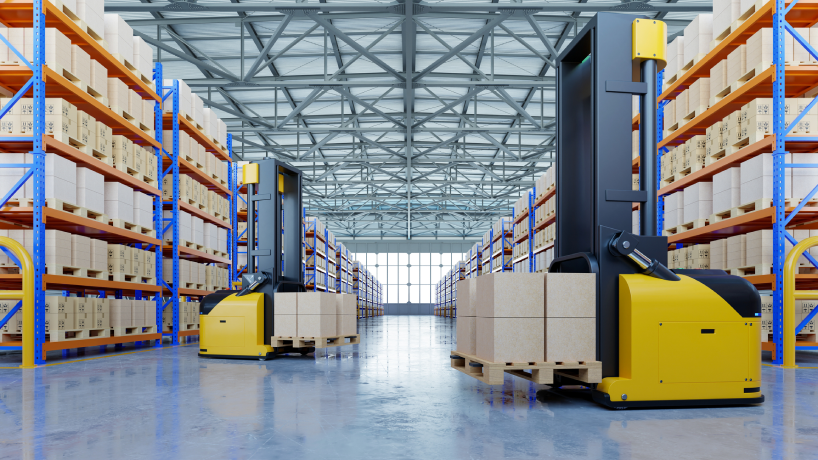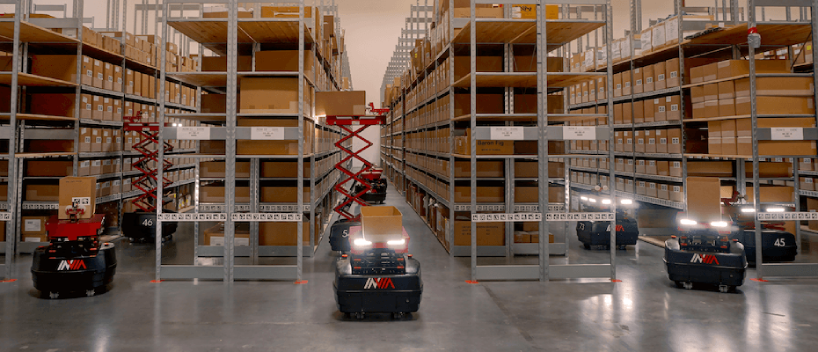
As online orders and e-commerce continue to grow as a portion of the retail and wholesale markets, more and more companies are looking to automate. Robotic automation can dramatically reduce the time it takes to fulfill an order, improve the productivity of warehouse employees and in turn drive customer satisfaction.
If you’re in the market for robots to help automate your warehousing processes, you have likely come across AGV and AMR robotic solutions. The terms often appear in connection with warehouse and factory automation. Automated Guided Vehicles (AGVs) have been around since the 1960s. Autonomous Mobile Robots (AMRs) have existed for two decades, with comprehensive commercial implementation only in the last ten years. If you’re like many people, you may have found the terminology to be somewhat confusing. Some sources use the terms interchangeably, others consider an AMR a type of AGV.
In this article, we explore the similarities and differences between AMRs and AGVs as applied to warehouses and distribution centers and offer explanations of how these robotic solutions enable warehouse employees to get more done in less time.
AGV Robots In Warehouse Automation
– What Is An AGV Robot?
Automated Guided Vehicles (AGVs) are unmanned load carriers directed by a combination of software and sensor-based guidance systems. The distinguishing feature of an Automated Guided Vehicle is that it follows a pre-established path. In that sense, an AGV is more like a train than a car. Sensors in the AGV detect obstacles and the AGV will stop and call for help if something blocks its path. (In contrast, an Autonomous Mobile Robot is more like a car because it can follow a variety of paths to get to its destination.)
– How Can AGV Robots Be Used?
AGVs are used to transport goods for larger and heavier payloads without the need for a human driver. The transported items can be stored on the vehicle on an onboard platform or sometimes on a roller, which can automatically load and unload the items. One common type of an Automated Guided Vehicle is a tugger that pulls a “train” of un-powered carts behind it.
AGV forklifts and pallet jacks are frequently used for transporting entire pallets of goods, and a manual forklift can be retrofitted to become an AGV. More commonly, an AGV is a purpose-built automated vehicle that has no cab for a driver. There are also hybrid vehicles that can be manually driven or automatically guided.
– Where Can AGV Robots Be Used?
AGV systems are often used for jobs that would usually be handled by conveyor systems, forklifts, or manual carts. They are best suited for environments that don’t change very often because the route the robot travels is the same every time. Factories that need to transport bulk raw materials are good candidates for AGVs. Examples include the chemicals and plastics industries, as well as steel mills and automotive manufacturers.

AGVs are unmanned load carriers directed by a combination of software and sensor-based guidance systems. (Image source: iStock)
AMR Robots In Warehouse Automation
– What Is An AMR Robot?
Unlike AGVs, Autonomous Mobile Robots (AMRs) can choose different routes to travel to their destination. If one pathway is blocked, the AMR can choose a different one, because the robot has a map of the facility stored in its memory. Their onboard sensors enable AMRs to detect obstacles and automatically navigate around them.
– What Types Of AMR Robots Are There?
Technically, AMRs can be flying vehicles or two-legged humanoid robots, however as applied to warehouse automation, AMRs are commonly thought of as smart, four-wheel carts.
The AMR cart comes in many configurations, such as lifting mechanisms for transporting a shelf of goods or suction cups for grabbing individual totes as used by inVia Picker robots.
In the eCommerce fulfillment industry, the crucial distinction between AMRs is whether the system supports Goods-to-Person or Person-to-Goods fulfillment model. When mobile robots assist with Person-to-Goods order picking, associates are relieved of the need to push or pull a cart. Yet, these methods don’t reduce walking much. And in a warehouse, travel time is the enemy of efficient order picking. Walking can consume as much as 50% of the time needed to pick an order.
In Goods-to-Person automation, AMRs bring the goods to workers drastically reducing walking. inVia Robotics solution is Goods-to-Person automation. inVia Picker robots deliver inventory to inVia PickerWall where your people are directed on how many units to pick and which order containers to sort them into. The system eliminates costly warehouse walking, resulting in a 5X productivity increase.
– How Can AMR Robots Be Used?
Historically, AMRs have had a smaller carrying capacity than AGVs. AMRs continue to grow bigger, however. The variety of ways AMRs are used in warehouses is limited only by the imagination.
That said, the most labor-intensive task in warehousing is order picking. AMRs can reduce the labor content of order picking by minimizing warehouse walking. Manual order fulfillment requires people to walk the aisles of a warehouse to pick items off of shelves. Having the robots do the traveling reduces the cost-per-pick and saves wear and tear on people. Manual order picking can require people to walk from ten to fifteen miles per day.
Replenishment is another use for AMRs in the warehouse. Modern Autonomous Mobile Robot is in constant communication with a Warehouse Execution System (WES) and can be used to support a variety of operational workflows. The WES from inVia knows where all your products are located and directs its AMRs to pick and put away inventory containers.

AMRs can choose different routes to travel to their destination; their onboard sensors enable AMRs to detect obstacles and automatically navigate around them. (Image inVia Picker Robort)
AMR vs. AGV: Key Differences
– Flexibility & Scalability
AMRs are more flexible than AGVs because they don’t have to always follow the same route. While markers guide the AGVs from point A to point B along a well-defined path, the robots have no global view of the warehouse or their location in the facility. So to define a new path for the AGV, you have to move the magnetic strip or similar markers.
AMRs have the ability to change their path and can more readily adapt to changing conditions. In Goods-to-Person automation, such as inVia Robotics, AMRs move completely autonomously to automate all order fulfillment tasks. Smart algorithms calculate the most efficient paths for robots to retrieve and move goods to warehouse workers so that they can quickly pick, scan, and sort items for packing and shipping to customers.
– Infrastructure Changes/Implementation
AGVs typically use markers that are permanently fixed, for example, magnetic strips that are embedded in the floor. When your floor plan changes, AGVs will need new routes defined, and that involves reinstalling the markers.
Various AMR technologies on the market will have different implementation requirements. Some require significant infrastructure changes to ensure robots have the ability to move racks or access inventory containers.
inVia Picker robots adapt to existing flooring and racking so there is no need for infrastructure changes. The robots use an extendable lift to reach upper shelves and an industrial suction cup that seals a secure grip on totes enabling them to be transported by the robot to inVia PickerWall.
– Navigation
AGVs are characterized by fixed routes, while AMRs have intelligent navigation. There are times when a fixed route may be preferable. For example, if you want an AGV to move something as large as a locomotive engine from point A to point B.
Autonomous Mobile Robot can choose different paths because the robot has a map of the facility stored in its memory. Their onboard sensors such as laser sensors or cameras enable AMRs to detect obstacles and automatically navigate around them.
inVia Picker robots utilize machine vision with “fiducial” stickers. Our robots can detect the position and orientation of a fiducial sticker with ultra-precision. By sticking these fiducials all over a warehouse, robots can easily localize themselves. Software remapping can change the paths of the robot without a need for extensive changes to the infrastructure.
– Data & Intelligence
Since AGVs have pre-established paths and act more like a train than a car, there is a limited need for intelligent guidance. AMRs can move autonomously and are more suitable for dynamic environments where requests are constantly changing. That’s why AMRs are so widely used in eCommerce fulfillment, where new orders are coming in all the time, and customers are changing or canceling lines from their orders. The robots and the intelligent software that guides them must be agile to quickly adjust to changing priorities. AMRs are in constant contact with the Warehouse Execution System (WES). The WES instructs the AMR where to go next and the AMR updates the WES on its activities.
– Cost
It’s difficult to compare costs between AMRs and AGVs because they are two different solutions with different warehouse applications. AGVs tend to be larger and heavier than AMRs since they’re often designed to carry heavier loads. Therefore AGVs are often more expensive than AMRs.
In the past, AGVs were a more cost-effective solution because they only required a simple magnetic tape to navigate the warehouse. Today, sensors and computing power have become inexpensive, driving down the cost of building and operating a high-quality AMR. With intelligent software, these inexpensive autonomous robots can support a variety of warehouse functions, delivering faster and more efficient order fulfillment.
– Maintenance
Maintenance costs between the machines themselves are likely to be about the same. Both may need some lubrication, and some parts will require replacement. The major difference in maintenance requirements depends on how well the robot can adapt to differences in the environment. If a magnetic tape installed on a floor to guide AGVs becomes worn over or damaged, AGVs will stop operating until it is replaced. AMRs can adapt to changes in the environment and work around faulty or aging hardware. That ability to adapt is the main driver of maintenance requirements for robots to operate without disruptions.
Conclusion
Although AGVs and AMRs can both be used to transport goods within your facility, they have quite different warehouse applications. The AGVs are most often used for larger, heavier payloads, that need to be moved along the same defined path. AMRs are much more flexible and intelligent in the way they navigate the warehouse and are optimally used for order picking, replenishment, and transporting boxes rather than large objects.
Request a demo to learn more about inVia’s Goods-to-Person automation system.
